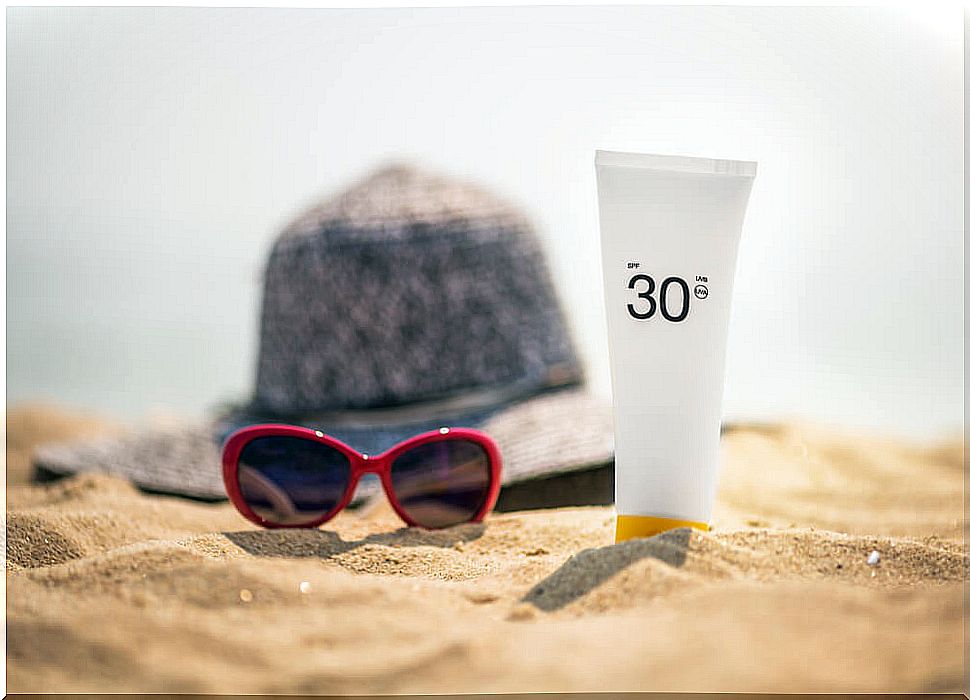Solar Erythema: Recommendations And Care
Solar erythema is the typical sunburn that we suffer when we are subjected to ultraviolet radiation for a long time. In general, the most intense symptoms appear in the first 24 hours and then begin to decline.
What is known as solar erythema is a set of entities with different severity. There are slight lesions, with only a peeling of the superficial layer of the epidermis. However, at other times, the burn sheds a patch of skin and causes blisters.
In either situation, the affected area becomes red from blood congestion. There is not always inflammation, but it can happen that the flow of fluids in the tissues increases their volume.
As we have said, this solar erythema comes from the action of the sun’s ultraviolet rays. Although there are different wavelengths in the sun’s rays, the radiations that most affect the skin are UVB and UVA.
UVA radiation is very penetrating, and can reach the dermis, which is below the epidermis. Its negative effect is manifested in the long term. Accelerates cellular aging and favors the development of skin cancer.
On the other hand, UVB radiation is the direct culprit of solar erythema. The skin tans and burns from this radiation. It is also capable of altering cells, turning them cancerous. Therefore, both radiations are an oncological risk factor.
Risk groups for solar erythema
We can all suffer from solar erythema if we expose ourselves inappropriately to the sun’s radiation, at times that are not recommended and without protection. In any case, certain population groups are more prone to these burns; among them are the following:
- Those who have to work, yes or yes, in homeless environments, at noon.
- People with a very light complexion.
- Those who carry out water sports or mountain activities, since the reflection of the water and the snow is capable of burning with the same intensity as direct light.
- Inhabitants of tropical areas, where the direction of the sun is more perpendicular to the earth and the radiation schedule is longer.
- Patients medicated with some antibiotics, such as doxycycline.
- Chronic patients with autoimmune diseases with dermal involvement, such as lupus.

What to do before a solar erythema?
Once the solar erythema has been established, the measures to be taken should be to alleviate the injury. A medical visit is not usually necessary in these cases. However, if doubts are raised about the evolution of the burn, it is advisable to consult.
If we know that we were very exposed to the sun and that the erythema will surely appear, we should shower with cold water when we return home. Cold objects can also be placed on the affected skin to begin to control the inflammation that is going to be generated.
Clothing should be loose-fitting during the days that the erythema lasts. The rubbing of shirts and pants hurts and hurts, in addition to promoting flaking, which can be dangerous if there are blisters.
In the case of having blisters with liquid, it is convenient not to burst them. You have to let them evolve without too much intervention. Creams with pain relievers and coolants can be placed around it, as well as the vesicles sealed with a sterile bandage so that they do not become infected.
Regarding medication, the article “Approach to the treatment of skin aging” in the journal Ars Pharmaceutica proposes the use of gotu kola in creams. This would stimulate the production of collagen to repair the skin. Orally, paracetamol would be indicated to control pain.
Take care of yourself with sunscreen

Sunscreen creams are a fundamental tool in summer and throughout the year. Dermatological associations recommend its use when directly exposed to the sun and even more so in risk groups.
What sunscreen does is reflect radiation or absorb it to prevent it from reaching the skin. The unit of measurement used for these preparations is the sun protection factor (SPF). Each SPF is linked to a percentage of filtration of UV radiation.
In practice, a sunscreen with SPF 30 is sufficient for most cases, since it blocks 96.7% of the radiation. Using a larger number is useful on the face, children or people with very fair complexions.
How to apply and maintain it is key. Avoiding sunburn depends on the cream being evenly distributed on the body and a layer of at least 2 milligrams per square centimeter of skin is formed.
Taking care of sunburn is a healthy habit
Although it may not seem like it, taking care of solar radiation is a habit that affects our future lives. We can avoid most cases of skin cancer if we respect the minimum measures of exposure to the sun and use adequate sunscreen.
When in doubt about a dermal injury, be it a sunburn or a more serious burn, it is advisable to consult a doctor. It is preferable to take advice on the seriousness of the condition and act accordingly.









